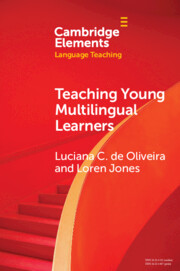Element contents
Teaching Young Multilingual Learners
Published online by Cambridge University Press: 20 January 2023
Summary
Keywords
- Type
- Element
- Information
- Series: Elements in Language TeachingOnline ISBN: 9781108934138Publisher: Cambridge University PressPrint publication: 02 February 2023
References
- 13
- Cited by

